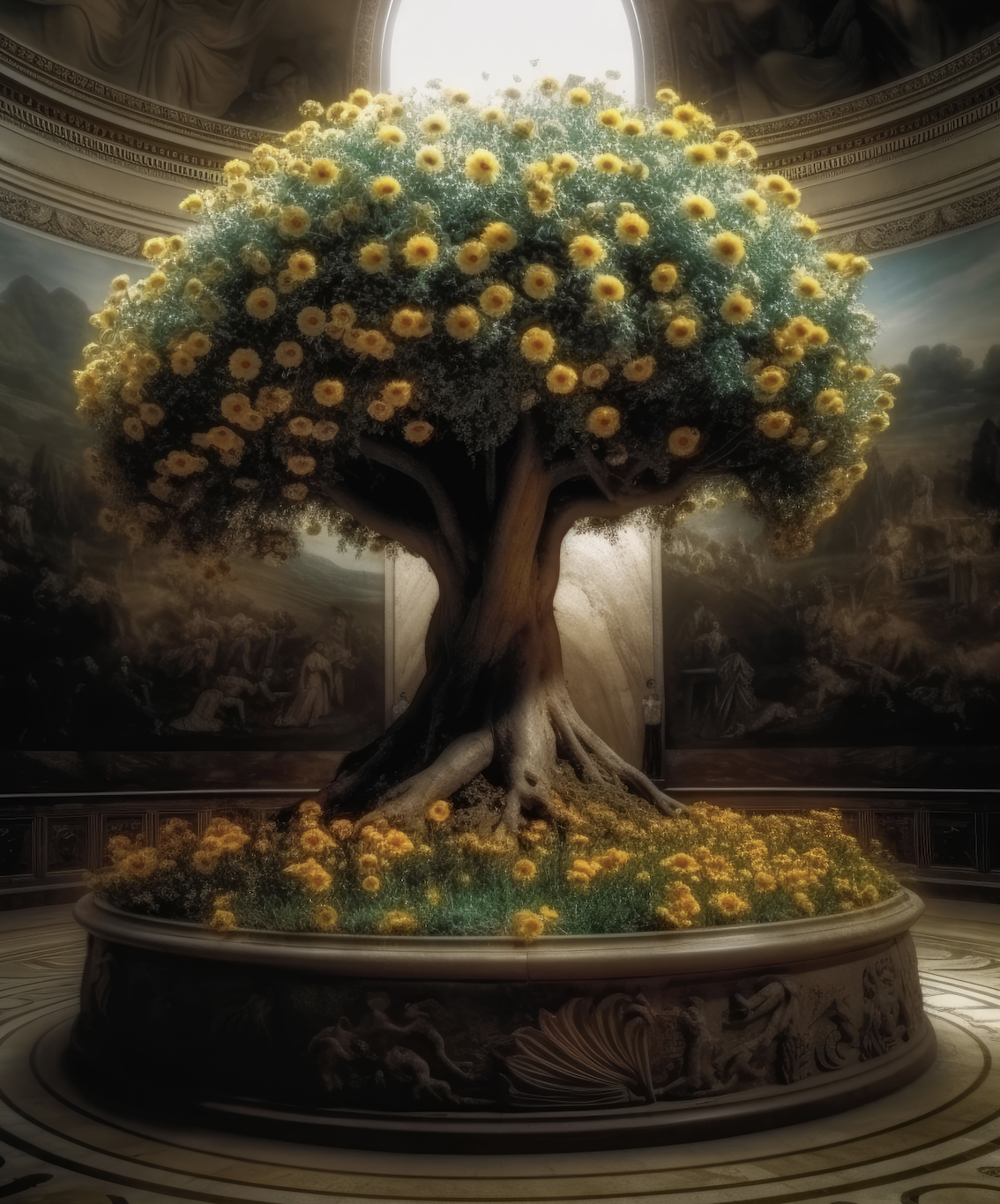Intelligences alliance
The Cart of Dreams depicts a shopping cart filled with food products and party balloons flying in the sky with hot air balloons. Of all the artworks in The art of two partner intelligences—the exhibition at the start of the annual NielsenIQ conference on large consumption—it is the one that best represents the wishes of the hundreds of sponsors meeting in the Sardinian beach town of Santa Margherita di Pula. Shopping for groceries soars like profits. Rocco Tanica has hit the mark.
Rocco Tanica is the stage name of Sergio Conforti, who is best known as the keyboardist of Elio e le Storie tese, but is also many other things: a composer, comedian, Italian TV writer, and recently an illustrator of images created with artificial intelligence.
“All of the artworks in the exhibition, commissioned by large consumer groups, have been created using artificial intelligence,” he tells MAG1861. This is the first time his work, which he signs RoTa, is included in an art show. He is very happy and excited: “After taking an indefinite break from music, which I thought was the only art form for me, I fell in love, to different degrees, with photography, illustration, writing, and artificial intelligence applications.”

How do you get started? “There are hundreds of platforms you can use, offering a variety of tools and results. You just tell the application what you want to do, and it will come up with suggestions. The more precise you are, the better the results.”
The results you get are immediate, but then the real work begins. “It took close to 20 hours to realize The Cart of Dreams. It may have been due to my inexperience or just technical issues, but it was a struggle to make it fly, although I said it should fly easy. In the end, I used a prompt assigning a value to my specific request. The higher the value, the more the application understands what aspect to pick.”
So, where does the artist come in on this? “The idea and the goal both belong to the person, together with all the changes made to achieve a certain result. Creativity is always at the basis of it.” “It’s a little like the difference between traditional film cameras and digital cameras Anyone can create images with AI, but what really matters is the human contribution,” Tanica adds.
The idea and the goal both belong to the person, together with all the changes made to achieve a certain result. Creativity is always at the basis of it
The companies that commission Tanica’s artworks want to convey the values of “Italianness” and “tradition.” As he puts it: “In several cases, I thought of Caravaggio and ended up explaining to the application what his paintings are like and how he used light, such as in the case of CRAI’s daisy tree.

Tanica believes that to use artificial intelligence is neither a limit nor a sin: “The important thing is to make it explicit. The sin of insincerity belongs to those who churn out works while failing to say that they used AI.” He also predicts that a time will soon come when mixed techniques will be a commonplace trend, which already exists in art. Mixing genres has never borne bad fruit, only stagnation has.”
Illustration isn't a new infatuation for him. “I have always drawn with joy and pleasure dedicating myself to the single stroke with a pen or pencil. Color does not interest me. I stopped doing colors right after kindergarten." He has always paid particular attention to images, including with his band, also known as Elii: “I created some album covers, starting with the one for “Elio Samaga Hukapan Kariyana Turu” from 1989, which shows a young man from Senegal wearing a blond Northern European bob hairstyle and a lace shirt.”
Using artificial intelligence is neither a limitation nor a sin
looked for a female model with an oval shape face and finally the Senegalese guy. It looks like it could be a photomontage, but we actually used a piece of software, the same as advertising did at the time, although little known to most. Back in 1989, it was definitely an exciting challenge”.
The album was a hit and people liked the cover, so Rocco Tanica went at it again with the cover of “Italyan , Rum Casusu Çikti,” from 1992. “I don't know if the inspiration came from a dream I had as a child or the peppers I ate the night before, but I got the idea of depicting a bipedal cow. A cow that stood on human feet, belonging to a friend of ours, as a matter of fact. They were perfect. I was the one most interested in the matter of the covers, but everyone chipped in.”

Tanica recalls with amusement how the image was created: “We started with the shirt, then we
Tanica has been mostly influenced by the world of comics and he greatly admires Andrea Pazienza, Tanino Liberatore, and Carl Barks. However, he is smitten with the works of Italian painter Canaletto: “His nearly photographic precision baffles and moves me. I spent entire days touring museums so I could study his works.”
He doesn’t think you should use ChatGPT, because it’s too geeky, politically correct, legally minded, and won’t give out any inconvenient information
Tanica has a message for us: “I invite everyone not to consider illustration and artificial intelligence as reserved for the few. Test, experiment, use AI in images and writing. Get a free trial membership. It's free and fun, why not do it?”
Nevertheless, the artist warns that not all applications are great: “Don't use ChatGPT, because it’s too geeky, politically correct, legally minded, and won’t give out any inconvenient information. Its great limitation is the specific programming that has been done to be able to spread it more easily. I do not agree with fact that such an aggressive media—which people will soon start relying on blindly—is designed like that.”
Read
8 settembre 2023
The continent's best designers in the glass cloud of the Axica Convention Center, in Berlin. Two industry awards to designers from Smeg and Brescia-based Jarsty
8 giugno 2023
The project ‘Chiesa di Santa Maria Goretti’ by MCA - Mario Cucinella Architects wins the Architizer A+Awards